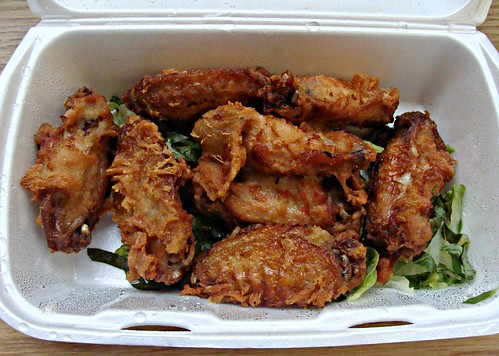The probe-protein complexes have been separated from the cost-free probe on a six% native polyacrylamide gel in the TGE buffer (twenty five mM Tris, 189 mM glycine, one mM EDTA) and visualized by autoradiography. Opposition assays have been carried out by incubating nuclear extracts with labeled probes in the presence of a hundred-fold molar excess of unlabeled oligonucleotides for 30 min at place temperature. To perform supershift experiments, nuclear extracts ended up incubated with labeled probes in the presence of .four mg of an antibody from NF-kB p65 (sc372, Santa Cruz Biotechnology) or NF-kB p50 (sc-114, Santa Cruz Biotechnology) for one h at area temperature. Preimmune rabbit IgG was utilized as a management antibody.
The ChIP assay was done using the Magna Chip A package (Upstate Biotechnology, Lake Placid, NY) according to the manufacturer’s instructions. Briefly, AGS cells were handled with one% formaldehyde at area temperature for 15 min. Glycine was added to a last focus of .one hundred twenty five M to end the cross-linking reaction. The cells ended up collected and lysed followed by centrifugation at 20006 g for five min. The pellets had been gathered and resuspended in the nuclear lysis buffer adopted by sonication to shear DNA to about five hundred to a thousand bp fragments making use of Bioruptor UCD-200 (Diagenode, Liege, Belgium). The crosslinked chromatin was subjected to immunoprecipitation with a rabbit anti-p65 antibody (Mobile signal, Danvers, MA) or an isotype antibody right away at 4uC followed by the addition of  protein A magnetic beads (Upstate Biotechnology). Soon after five-h incubation at 4uC, the immunoprecipitates ended up then sequentially washed with minimal salt, high salt, LiCl and last but not least TE buffer. The washed immunoprecipitates had been then subjected to cross-link reversal in the elution buffer at 65uC right away adopted by removal of the beads employing a magnetic separator. DNAs in the supernatants ended up purified and subjected to quantitative PCR analysis using primers made from the NF-kB consensus binding internet site in the CCL20 promoter (ahead, 5AGGATTCTCCCCTTCTCAAC-39 reverse, 59 GGATGGCCCTATTTATAGCA-39) and SYBR Environmentally friendly fluorescent dye (Bio-Rad).
protein A magnetic beads (Upstate Biotechnology). Soon after five-h incubation at 4uC, the immunoprecipitates ended up then sequentially washed with minimal salt, high salt, LiCl and last but not least TE buffer. The washed immunoprecipitates had been then subjected to cross-link reversal in the elution buffer at 65uC right away adopted by removal of the beads employing a magnetic separator. DNAs in the supernatants ended up purified and subjected to quantitative PCR analysis using primers made from the NF-kB consensus binding internet site in the CCL20 promoter (ahead, 5AGGATTCTCCCCTTCTCAAC-39 reverse, 59 GGATGGCCCTATTTATAGCA-39) and SYBR Environmentally friendly fluorescent dye (Bio-Rad).
Plasmids encoding wild kind STAT3 (pCMV2-FLAG-STAT3) and dominant damaging STAT3 (pCMV2-FLAG-STAT3DN) ended up produced by cloning the coding locations of wild-sort or dominant damaging STAT3 (Y705F) into pFLAG-CMV2. AGS cells were transfected with si-RNA#b jointly with possibly pCMV2-FLAG-STAT3 or pCMV2-FLAG-STAT3DN. At 36-h put up-transfection, the transfectants were infected with H. pylori in the presence or 1032350-13-2 absence of IL-22 adopted by the dedication of CCL20 concentration in cell lifestyle supernatants at six-h postinfection. CCL20 in the mobile tradition supernatants 19805493was measured by ELISA (R&D program) in accordance to the manufacturer’s protocol.
AGS cells have been lysed in the Lysis-M Reagent (Roch, Mannheim, Germany) containing protease inhibitor cocktail (Roch) and phosphatase inhibitor cocktail (Sigma, St. Louis, MO). Fifty micrograms of mobile lysate proteins ended up separated beneath lowering circumstances on a seven.5% SDS-polyacrylamide gel and proteins were then transferred onto nitrocellulose membranes (Perkin Elmer, Waltham, MA). The membranes were blocked with five% milk in TTBS (a hundred and fifty mM NaCl, a hundred mM Tris pH seven.five, .one% Tween 20) for 1 h before incubated with anti-phosho-STAT3 (Cell sign Technological innovation, Beverly, MA) at 4uC right away, followed by three washes. The membrane was then incubated with peroxidase conjugated goat anti-rabbit antibody for 1 h at space temperature followed by three washes, and lastly subjected to chemiluminescence making use of the ECL reagent (Perkin Elmer, Waltham, MA). The very same membrane was subsequently stripped and blotted with antiSTAT3 (Santa Cruz Biotechnology) or anti-b-actin (SignaAldrich).
